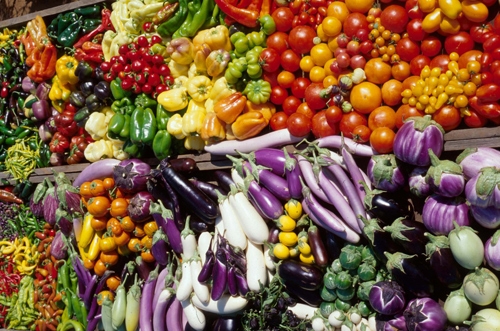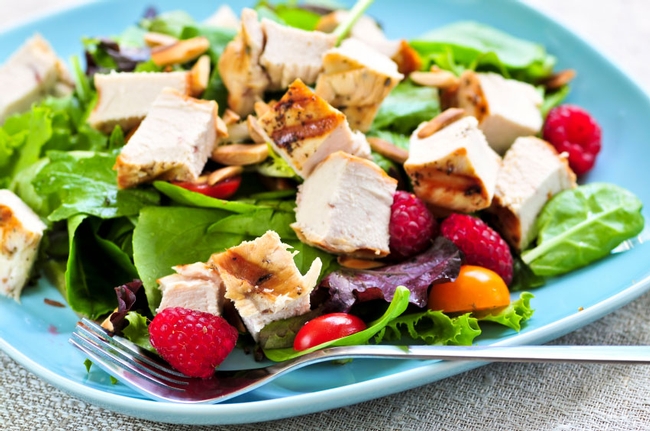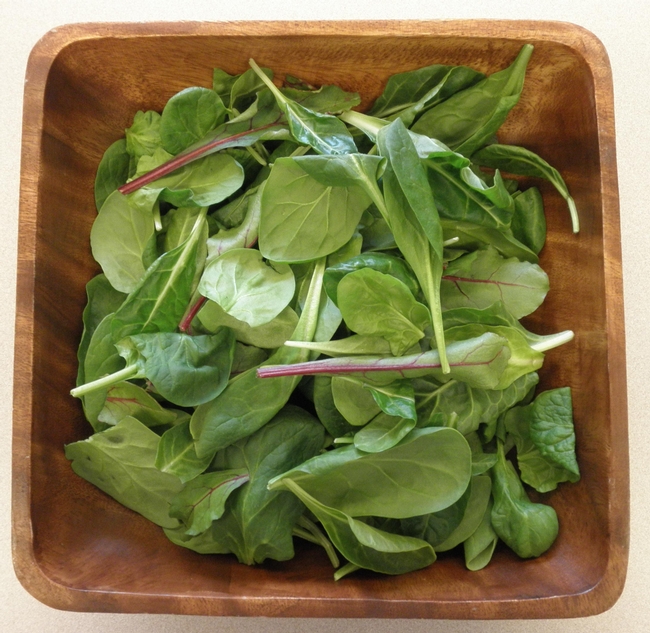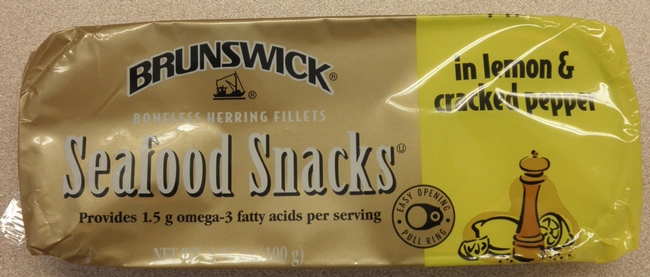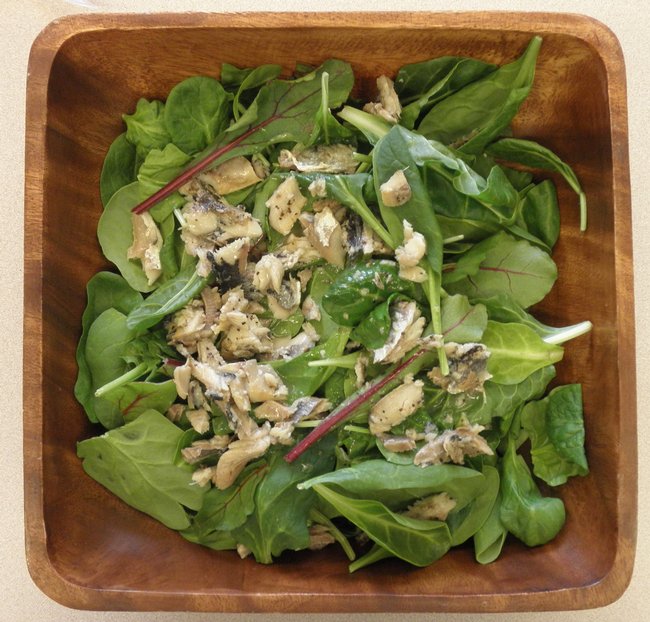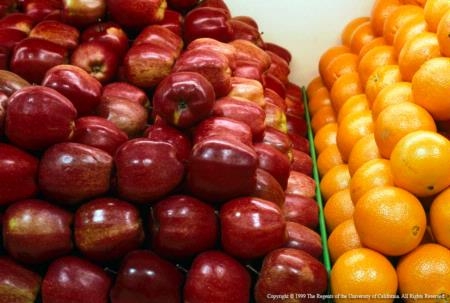Posts Tagged: healthful eating
Choosing healthy foods might be easier than you think
Doctors say we'll live longer if we exercise and eat right. Okay, but what does that mean, exactly? You hear so much about super foods and super diets that knowing how to “eat right” can be super confusing.
It doesn't have to be. Liz Applegate, a nutrition and fitness expert from UC Davis, has teamed up with Nugget Markets (a chain of nine markets which serve the greater Sacramento Valley) to present a “21-day Healthy Eating and Exercise Challenge,” an easy plan for making health a permanent part of our lives.
“This isn't about starving yourself or biting off more than you can chew at the gym,” Applegate says. “It's about making good-for-your-body decisions, rather than punishing you with cutting calories and tough-to-do workouts.”
Applegate teaches nutrition at UC Davis, including a wildly popular online and in-person nutrition course that attracts several thousand students each year. She's a triathlete, a sports nutrition columnist for Runner's World, an author of several sports nutrition books, director of sports nutrition for Intercollegiate Athletics at UC Davis, and a consultant for Olympic athletes.
In short, she knows her stuff. And when it comes to healthy eating, she says, don't over-think it.
“Eating well isn't about being perfect, but about finding out what food has to offer, and striking a balance between your needs, personal preferences, culture and family experience,” she says.
That philosophy is central to her healthy eating and exercise challenge, which you can pick up at any Nugget Market or download from its website here. Applegate's shopping list includes a wide variety of tasty foods — a bounty of fresh vegetables, various meats and poultry, fish, eggs, grains, dairy, chocolate and much more. What's not to like?
- Eat breakfast. A solid morning meal sets the stage for a good day of healthy eating.
- Eat some protein at every meal to manage weight and support your exercise.
- Whole grains like brown rice, quinoa and whole wheat are your friends (unless you cannot tolerate gluten. If so, stick with brown rice and other non-wheat products).
- Aim for at least 2½ cups of veggies and 2 to 3 pieces of fruit each day.
- Include healthy fats from fish, nuts and seeds. Use olive, canola or avocado oils.
- Aim for 2 to 3 servings of calcium-rich foods like dairy or soymilk. Each day, eat a probiotic such as yogurt or kefir for digestive and immune support.
As for fitness, the plan provides a do-at-home circuit of strength training exercises, such as planks, push-ups, squats and leg lifts. Her general rules are:
- Switch things up. You'll build stronger muscles when you try different types of exercises.
- Aim for 30 to 60 minutes of moderate to vigorous activity five to seven days a week. Anything that boosts your heart rate counts — fast walking, jogging, bike riding, swimming, dancing, basketball, you name it. If you can't find time for 30 minutes straight, 10 minutes here and there will do the trick.
- Include three to five do-at-home strength-building sessions that help shape and tone major muscle groups while building core strength.
Adjusting to healthy eating and routine exercise takes time, Applegate says, so don't be too hard on yourself.
The joy is in the journey.
What does 'eating right' really mean?
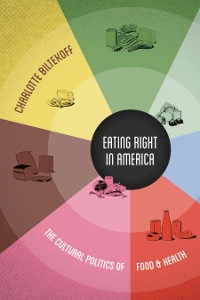
But the truth is, dietary advice is nothing new. Some of our rules for eating date back to ancient times as part of religious teachings, and food traditions are central to our understanding of culture. What is new over the last century or so is the application of science to our diets, so that we can know more exactly what nutrition science tells us is best when it comes to filling our plates.
A new book by a UC Davis researcher argues that modern dietary advice is not merely scientific, but also continues to have cultural, ethical and moral messages attached to it.
“Eating Right in America: The Cultural Politics of Food & Health” analyzes how modern dietary reform movements in the United States do not just tell us how to eat right, but how to become a good person and a good citizen. Can eating a certain way make us into different, somehow better people? And who defines what sort of people we should strive to become, though improved eating? Author Charlotte Biltekoff calls for changing the way we think about what it means to “eat right.”
The book analyzes four dietary reform movements over the last century:
- the rise of domestic science and home economics,
- the national nutrition program during World War II,
- the alternative food movement, and
- the anti-obesity movement.
These reform movements cover nutritional advancements such as the science of cooking, the discovery of vitamins, the shift in emphasis from contagious to chronic diseases, and the increasing importance of diet and lifestyle as a part of health. The book examines how dietary ideals have shifted, how social ideals have shifted alongside them — and the relationship between the two. Notions of middle class identity, good citizenship and individual responsibility each have been mixed in with nutritional advice before it is served to the public, according to the author.
Rose Hayden-Smith, leader of UC ANR’s Sustainable Food Systems strategic initiative and a historian of gardening, said she can't wait to read this book.
“This whole idea of both empirical and ethical considerations of food choices really makes sense to me, rooted in the Progressive Era,” she said. “All of these scientific advances don’t matter if people don’t adopt them. So I think it’s really important for scientists to understand the cultural context into which their work is going.”
Beth Mitcham, UC Cooperative Extension specialist in the Department of Plant Sciences at UC Davis, was intrigued by a presentation given by Biltekoff at UC Davis recently.
“This expands my way of thinking about the struggles we have with food choices and the potential for complicating well-intentioned messages,” she said. “We can’t ignore the scientific evidence that food choices have a huge impact on our health, but we must also realize when the things we’re saying are charged with judgments."
In a recent interview on Capital Public Radio, Biltekoff pointed out how analyzing history can shed light on difficult truths.
“History is such a great tool for learning to see things differently,” Biltekoff said. “The history that I tell in the book suggests that we worry so much about what is good to eat because of the social stakes involved in 'eating right.' Because it’s not just about our physical health, but also about our sense of self and about our social standing. There's a lot at stake that we may not be conscious of, but really is part and parcel of the conversation about 'good' food.”
Watching your weight
If you want to maintain a healthy weight, UC Cooperative Extension advisor Susan Algert has some sage tips: snack wisely; eat more fruits and vegetables; keep a food record and stay active.
Algert shared the latest dietary advice from the U.S. departments of Agriculture and Health and Human Services with UC Office of the President employees at a brown bag event Wednesday in Oakland co-hosted by UC Health and UC Agriculture and Natural Resources. (Listen to an audio recording of the event.)
“How many of you really watch your weight?” Algert asked the audience. “No matter how hard we try, it seems to creep up a little bit as we get older.”
Indeed, studies have shown that adults gain an average of around a pound a year. How that happens might surprise you, according to Algert, a nutrition advisor with UC Cooperative Extension of Santa Clara, San Mateo and San Francisco counties.
Research from a large representative study of women in the U.S. shows that as little as an extra 13 calories per day – the equivalent of consuming one extra ounce of soda and walking one minute less – has led to an average weight gain of 35 pounds in 28 years since the 1970s. Eating an extra chocolate chip cookie every day for life? Expect to gain 6 pounds.
“People always say, ‘I don’t know how I gained it.’ We don’t usually gain weight by eating fruits and vegetables. It’s all those goodies loaded with fat, sugar and salt that we snack on,” said Algert, who previously was a clinical research nutritionist with UC San Diego School of Medicine’s Warren Celiac Center.
People also need to be careful when eating out. She pointed to examples such as Cheesecake Factory’s Bistro Shrimp Pasta, which has more than 3,000 calories – 1 ½ times the recommended daily caloric intake for an average adult – and Smoothie King’s 40-ounce Peanut Power Plus Grape smoothie, which contains about a cup of sugar and nearly 1,500 calories.
“If you eat out more than a couple of times a week, you’re in trouble because you’re likely consuming more fat and calories than you realize,” Algert said. Other key factors that lead to weight gain are decreased physical activity, increased television viewing, increased alcohol intake and poor sleep.
So what should you do?
Algert said two reliable sources of nutrition information are the U.S. Department of Agriculture’s MyPlate dietary guidelines and the U.S. Department of Health and Human Services’ DASH (Dietary Approaches to Stop Hypertension) eating plan, which focuses on healthy fat, fruits, vegetables and reduced-fat dairy and limits sweets to no more than five servings a week. Also, UC offers a variety of nutrition education, including the CalFresh program, which reaches 140,000 Californians a year.
Algert encouraged people to buy fresh, local food.
“Vote with your fork,” she said. “Don’t buy junk food. Support a healthy food environment by going to the community gardens and by going to the farmers markets.”
Another suggestion is to keep a food record – track what you eat, when you eat and what your mood is (do you eat ice cream when you are stressed?).
Most of all, keep trying. Even the experts wrestle with their weight.
“I am trying to increase my fruit and vegetable intake to the 8 to 10 per day recommended in the DASH diet. I have a bit of a sweet tooth. It is a challenge in today’s food environment!” Algert said.
A big bowl of dark leafy greens and ...
We all know that eating dark leafy greens is good for us, right? So that’s why for lunch lately I’ve been on a health kick to eat a big bowl of dark leafy greens topped with a lean protein source. I have, however, been subject to some good-natured ribbing around my office regarding my lunch selections. So I decided to research my lunch ingredients, and why I, as well as my inquisitive co-workers, already know it’s something of a power lunch, in the most nutritious of ways. First, the base of my lunch: a mix dark leafy greens (today it’s spinach, baby bok choy, and red and green chard).
The USDA describes the following general health benefits by eating your vegetables:
- Eating a diet rich in vegetables and fruits as part of an overall healthy diet may reduce risk for heart disease, including heart attack and stroke.
- Eating a diet rich in some vegetables and fruits as part of an overall healthy diet may protect against certain types of cancers.
- Diets rich in foods containing fiber, such as some vegetables and fruits, may reduce the risk of heart disease, obesity, and type 2 diabetes.
- Eating vegetables and fruits rich in potassium as part of an overall healthy diet may lower blood pressure, and may also reduce the risk of developing kidney stones and help to decrease bone loss.
- Eating foods such as vegetables that are lower in calories per cup instead of some other higher-calorie food may be useful in helping to lower calorie intake.
And specifically, dark leafy greens are nutrition-dense, with loads of vitamins (Vitamin K, C, E and B), minerals (iron, potassium, magnesium and calcium) and fiber. Additionally they contain beta-carotene, lutein and zeaxanthin, which aide in disease prevention.
Second, the toppings. I’ve left this part for the end, because those co-workers of mine thought you might not still be reading if I let you in on my super power lunch protein choice, so here it is: a can of herring.
Surprised? Yep, herring is really good (I already like herring, but I love the lemon pepper variety), and there’s no need to add dressing, just dump the whole can on your salad! Sardines, smoked oysters and tuna — all on the “Good alternative” or “Best Choice” list on the Monterey Bay Aquarium Seafood Watch — are also delicious. They’re also very convenient and relatively inexpensive, especially if you stock up when they’re on sale. Fish is a super-food of protein choices, evidenced by the USDA Dietary Guidelines for Americans 2010:
“Mean intake of seafood in the United States is approximately 3 1/2 ounces per week, and increased intake is recommended. Seafood contributes a range of nutrients, notably the omega-3 fatty acids, eicosapentaenoic acid (EPA) and docosahexaenoic acid (DHA). Moderate evidence shows that consumption of about 8 ounces per week of a variety of seafood, which provide an average consumption of 250 mg per day of EPA and DHA, is associated with reduced cardiac deaths among individuals with and without pre-existing cardiovascular disease.”
A recent USDA paper says fish consumption is especially beneficial to pregnant and lactating women: “increased maternal dietary intake of long chain omega-3 fatty acids, in particular DHA from at least two servings of seafood per week during pregnancy and lactation is associated with increased DHA levels in breast milk and improved infant health outcomes, such as visual acuity and cognitive development.” (See complete February 2012 article.) And, just as I was getting ready to submit my blog, an article entitled “Brainpower Tied to Omega-3 Levels” appeared in the NY Times. How’s that for timing!
All this is not to say that chicken breast, tofu or beans are to scoff at, but do you get your USDA-recommended two servings of fish a week? What about that recommended two servings of chicken breast? Or tofu? Even beans don’t get a mention of how many times a week you should eat them. And for this I get razzed by my co-workers. Hmmph—bon appetite!
Beyond New Year's resolutions: tips for good health
Oh January 1st, how I hate you. If you’re like me you’re still recovering from the month long holiday food hangover. With three months until spring and swimsuit season on the horizon, you’re feeling the pressure to lose the winter coat! As always, you make that infamous New Year’s resolution: TO LOSE WEIGHT!
“Gym membership here I come!”
“I will not touch another carb for the rest of the year!”
“No sweets ever again… after this one!”
“I’m on a new diet, I eat nothing and when I feel like I’m going to faint I eat a cube of cheese!”
Okay the last one is my favorite quote from the Devil Wear’s Prada, but working in the health field I have found that sometimes people actually think that’s a solution. We find ourselves making resolutions that eliminate entire food groups from our diets, because we think it will help us lose weight. The thing most people don’t know or realize is that sometimes the absolutes we make can be very harmful to our health, and in the long run can actually cause us to gain the weight back plus more.
So this year, let’s make an attainable, realistic goal. Here are three tips selected from www.choosemyplate.gov, to have a healthy year!
- Put a positive spin on it – instead of saying “I can’t eat any sweets at all!” try a few “I will” statements on for size:
- I will add 1 serving of fruits and vegetables to each meal.
- I will make half of my grains whole.
- I will choose water or low-fat milk more often.
- Build a healthy snack – instead of buying the expensive processed snacks, try these healthy tips:
Combine fruit and a dairy food for the morning munchies:
- Apple and cheese
- Banana and yogurt
Combine vegetables and a protein food for a p.m. pick-me-up:
- Celery and peanut butter
- Carrots and almonds
Combining these foods will help you stay fuller longer while increasing your nutrient consumption.
- Don’t discount physical activity – being healthy isn’t about just what you eat. Adults need 30 minutes of physical activity a day and children need 60 minutes. Just because you don’t have a gym membership doesn’t mean you can’t be physically active. Remember that 30 minutes can be broken up throughout the day.
Here are some tips to increase your physical activity incrementally, without breaking the bank:
- Start a walking club with your co-workers, neighbors or friends. You’re more likely to do it if someone keeps you accountable.
- Do what you like! If you hate to run, don’t do it. There’s no use in driving yourself crazy doing something you hate. If you like to dance, then turn the radio up and have fun!
- Do stretches, exercises, or pedal a stationary bike while watching television.
Remember to always consult your physician before beginning a rigorous exercise regimen.
May your new year be full of realistic, attainable, resolutions! Keep it positive. Select healthy snacks that help you stay full longer. Get moving so you have more energy during the day. For more information and health tips visit www.choosemyplate.gov.
Wishing you all a very healthy 2012!



